Rictus Mortis – Killer Clowns
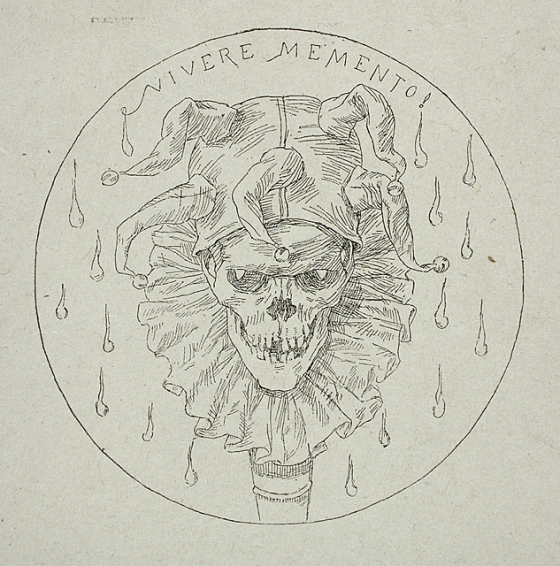
Rictus Mortis: Killer Clowns Vivere Memento, Felicien Victor Joseph Rops, c. 1850 http://collections.lacma.org/node/249602
Unless you cover your eyes when the news comes on TV, you must have noticed that kreepy killer klowns and their kopy-kats have been kavorting all over the kountry for the last few months. They lure children into wooded areas; they stand in fright-wigged solitude on street corners; they attack with machetes, baseball bats, and balloons, spreading terror to a coulrophobic public.
We can’t help but be reminded of the various ghost-panics of the nineteenth century where ghost-impersonators in sheets and Women in Black in mourning veils flitted about in the dark terrifying communities despite a very real risk of being shot by a ravening posse. What puzzles me is that these apparitional imitators did this repeatedly, even as their armed neighbors were hunting them down. To my mind it borders on obsession or even fetish, but I suppose there is the thrill of getting away with it; the exhilaration of evading one’s pursuers and surviving to gas-light another day. Why else would an individual, in the midst of all this hysteria, don a clown mask, and knock at doors in Portsmouth, Ohio while carrying an axe? Death-wish much?
There have been suggestions that Pennywise, from Stephen King’s It is the origin of the current phantom clown panic, possibly as a viral marketing campaign for the film adaptation coming in 2017. Serial killer John Wayne Gacy’s character of “Pogo the Clown,” is another possibility. But clowns and their precursors, the fools and jesters, have been horrific figures for much longer than that, as we shall shortly see.
The Phantom Clowns are a primarily visual phenomenon. The clowns rarely speak, nor do they try to communicate by mime or by honking comic automobile horns. The visual image is the key: the make-up, the ruffles, the parti-colored suits, the big wigs and shoes, all of which add up to an intimidating, and to some, terrifying presence. Grainy videos and blurry photos hastily snapped on phones further enhance the unearthly vibe. Which leads me to a query I hope to answer in this post: What is the earliest depiction of an “evil clown”? [Right or wrong, I’m using the term interchangeably with the phrases “phantom” or “killer” clowns.]
Early images of jesters and fools can be damned unsettling. There is more than a hint of mental illness in some depictions and court “fools” were often those called “simple” or deficient in some way.
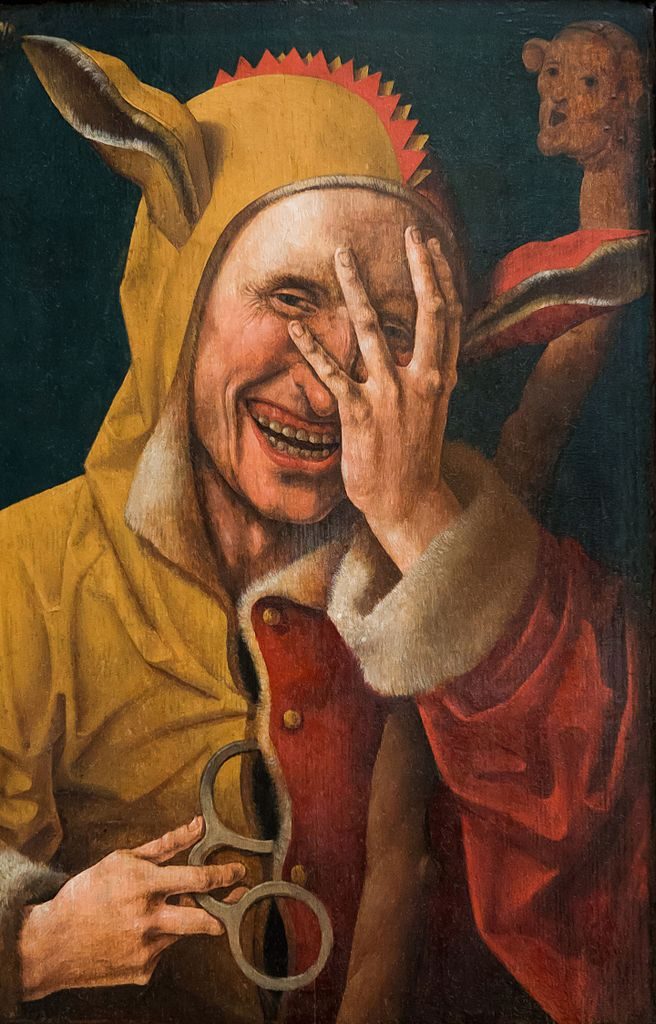
Laughing Fool, Netherlandish, possibly Jacob Cornelisz van Oostsanen, c. 1500 http://www.wellesley.edu/DavisMuseum/collections/provenance_research.html *http://mobius.wellesley.edu/detail.php?t=objects&type=all&f=&s=Laughing+Fool+Oostsanen&record=0 *http://mobius.wellesley.edu/browser.php?m=objects&kv=12940&i=17315
This image of a “laughing fool” shows the traditional ass-eared hood of the jester. In some images the ears are stiffened into devilish horns. Behind the Fool is his marotte, the jester’s scepter. Those are spectacles in his hand. I haven’t worked out the iconography: possibly it’s the notion of a “wise fool.”
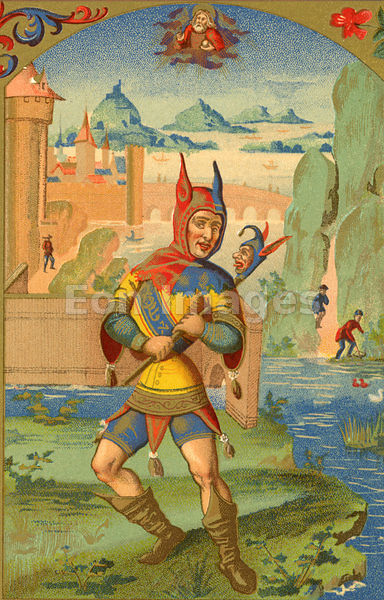
A Fool with horned hood and devilish marotte, from the “Cosmographie Universelle” of Munster: folio (Basle, 1552). Image date: ca. 1874.
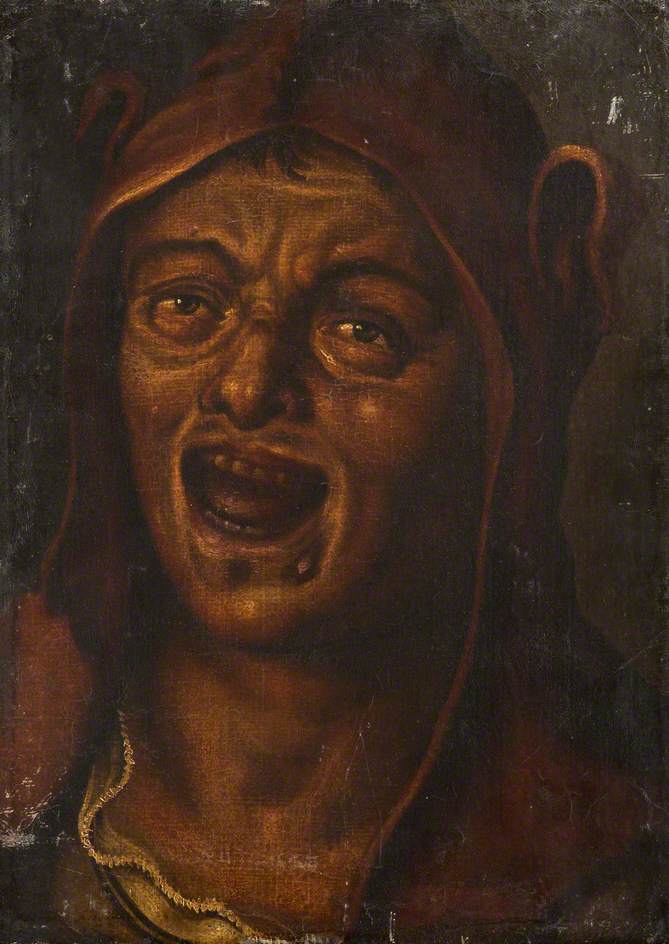
unknown artist; A Jester; Dulwich Picture Gallery; http://www.artuk.org/artworks/a-jester-200331
The hood and ears are more Ewok-like in this image, but are we looking into the face of madness or of evil?
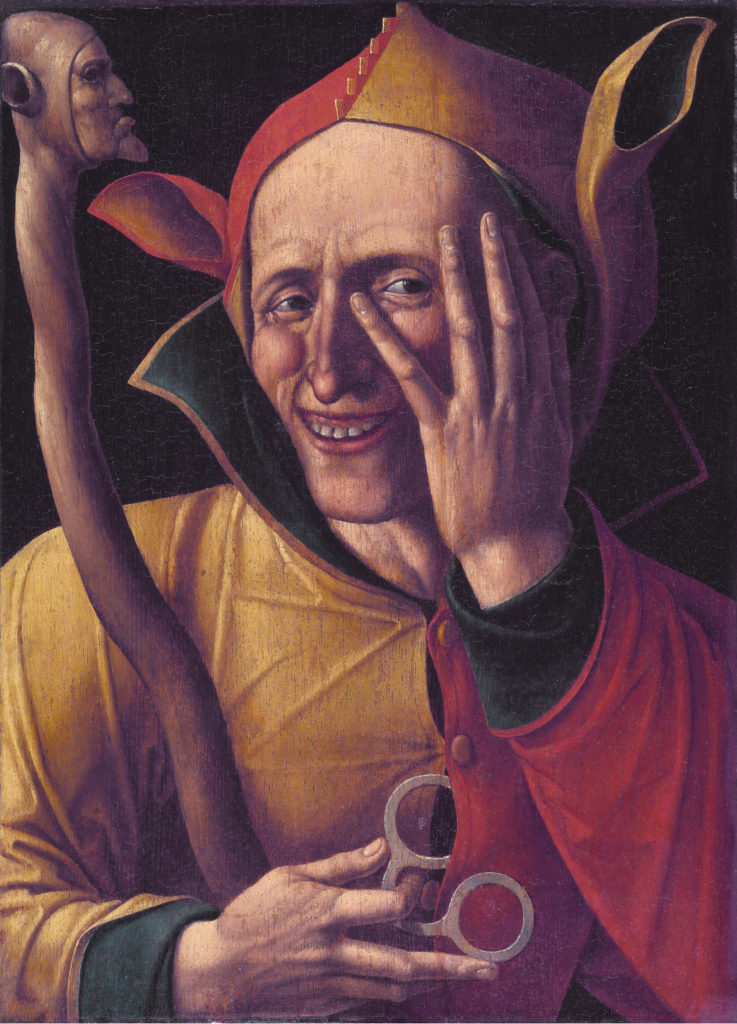
A later version of the “Laughing Fool” *1500s His marotte bears the face of a stern Norse god.

Fool and Girl, Werner van den Valckert, c. 1612 http://www.metmuseum.org/art/collection/search/402941?sortBy=Relevance&ft=fool&offset=0&rpp=20&pos=9
In these two prints by Werner van den Valckert, we see the rictus that makes clowns so terrifying.
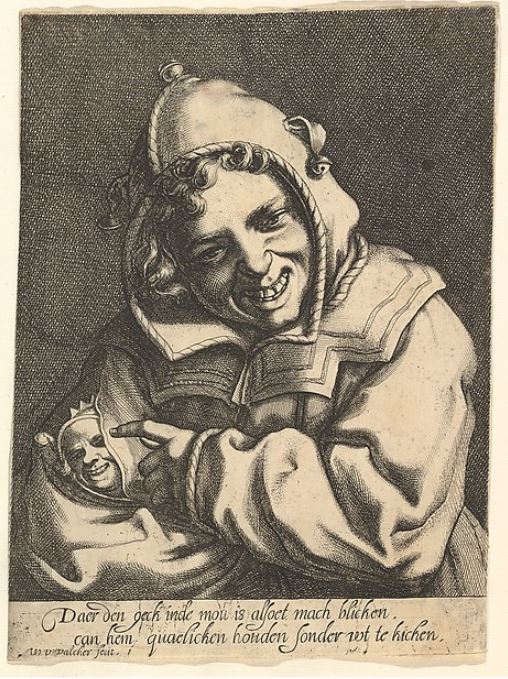
Laughing Fool, Werner van den Valckert, c. 1612 http://www.metmuseum.org/art/collection/search/400260?sortBy=Relevance&ft=fool&offset=0&rpp=20&pos=1
Madmen and Smilers are bad enough, but what if the jester was a more sinister figure than even those? This poem comes from A Masque of Dead Florentines, and is illustrated by the image below.
Pulci.
Let who wins laugh; I laugh’d at Heaven and Earth.
Dante saw Grief and lov’d her; I chose Mirth.
Mirth and I laugh’d till we were out of breath,
And left one laughing still—the jester, Death.
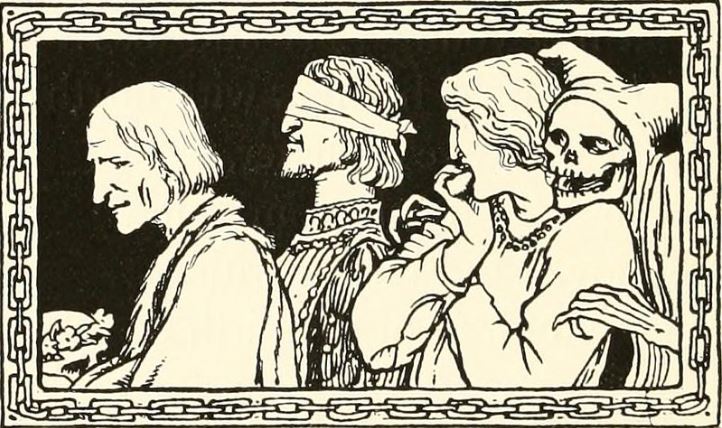
From A masque of dead Florentines : wherein some of death’s choicest pieces, and the great game that he played therewith, are fruitfully set forth” (1895)
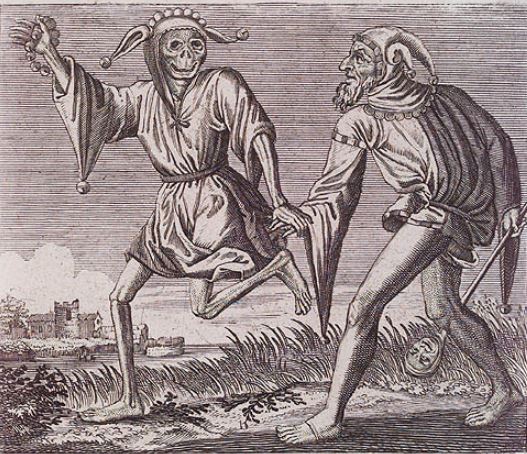
La Mort au Bouffon; Reponse du Bouffon, 1830 http://fantastic.library.cornell.edu/imagerecord.php?record=250
There’s that rictus again…
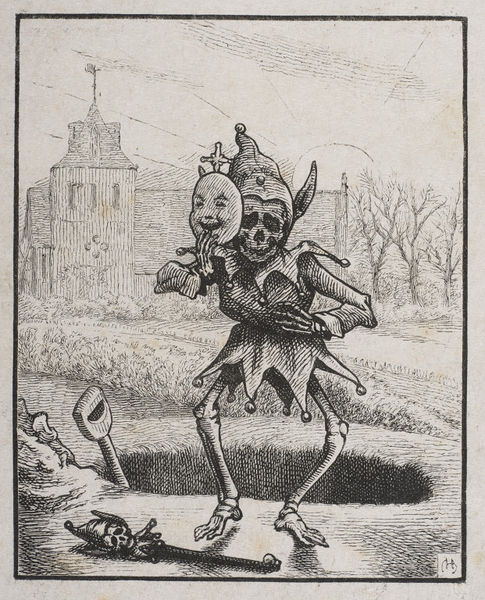
Death as a Jester, Charles Bennett, 1860 http://collections.vam.ac.uk/item/O12363/quarles-emblems-book-illustration-bennett-charles-henry/
In the traditional jester’s hood we can see the incipient clown’s pointed hat and the beginnings of a ruff around the neck. At a stretch, the wide-toed shoes of the sixteenth century [see the last two images in this post], or even the long-toed poulaine of the fifteenth, could be considered clown shoes in embryo….
Have we successfully unmasked the origins of the Killer Clowns? Jumping from the nineteenth to the sixteenth century, these next are the two oldest images of death-as-jester that I’ve found. Except for the nose, Death in the first picture looks rather like Heath Ledger as the Joker.
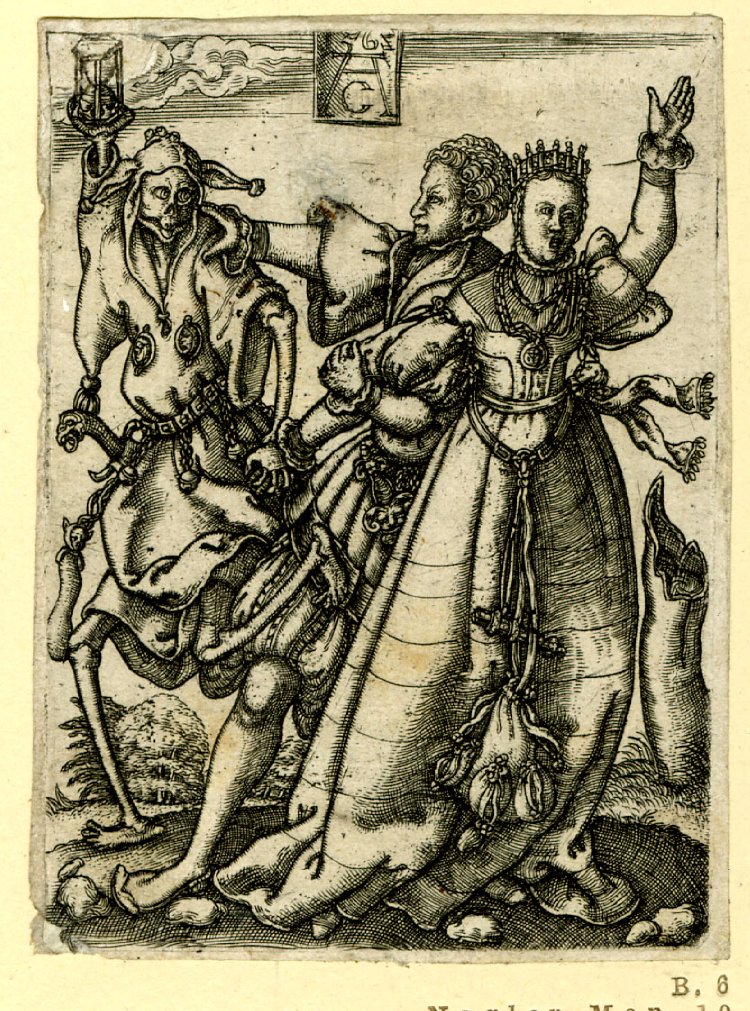
Death dressed as a fool, pursuing a couple with an hour-glass, Allaert Claesz 1562 http://www.britishmuseum.org/research/collection_online/collection_object_details.aspx?objectId=1452679&partId=1&searchText=jester&images=true&view=list&page=1

Hans Holbein, The Dance of Death, the Queen. 1526-7 https://ebooks.adelaide.edu.au/h/holbein/hans/dance/complete.html
Does anyone know of an earlier image of these proto-Killer Clowns? Put off the motley before contacting chriswoodyard8 AT gmail.com
Chris Woodyard is the author of The Victorian Book of the Dead, The Ghost Wore Black, The Headless Horror, The Face in the Window, and the 7-volume Haunted Ohio series. She is also the chronicler of the adventures of that amiable murderess Mrs Daffodil in A Spot of Bother: Four Macabre Tales. The books are available in paperback and for Kindle. Indexes and fact sheets for all of these books may be found by searching hauntedohiobooks.com. Join her on FB at Haunted Ohio by Chris Woodyard or The Victorian Book of the Dead. And visit her newest blog, The Victorian Book of the Dead.
